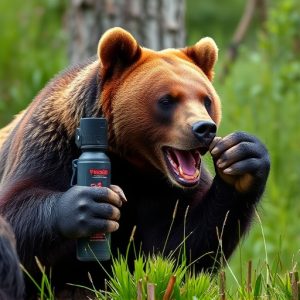Mastering Wilderness Survival: Bear Attack Protection Beyond Spray
Understanding bear behavior and taking proactive safety measures are crucial for survival in regions…….
Understanding bear behavior and taking proactive safety measures are crucial for survival in regions with bear populations. Key strategies include being mindful of wind direction to mask your scent, carrying and using bear spray effectively (at least 30-foot reach, FDA-approved, high capsaicin), and implementing additional precautions like keeping an upwind position, making noise, and carrying tools like air horns or bear bells. Combining these tactics with awareness of surroundings and local wildlife behavior enhances safety when venturing into bear country.
“Venturing into the wilderness comes with inherent risks, especially encounters with bears. Understanding bear behavior and utilizing the right tools can significantly enhance your safety. This article equips you with essential knowledge about bear senses and the crucial role of wind direction in navigating these encounters.
We’ll delve into the science behind bear spray, offering tips on choice and application for optimal protection. Additionally, discover a range of strategies beyond bear spray to fortify your wilderness survival skills.”
- Understanding Bear Behavior and Their Senses: Wind Direction and Bear Spray
- Choosing and Using Bear Spray Effectively for Safety
- Beyond Bear Spray: Additional Protection Strategies for Wilderness Survival
Understanding Bear Behavior and Their Senses: Wind Direction and Bear Spray
Understanding bear behavior is a crucial aspect of wilderness survival, especially when navigating areas known for bear populations. Bears have an incredible sense of smell and hearing, making them adept hunters. They can detect scents from long distances, up to a mile or more, depending on wind direction. This keen sense of smell is their primary tool for locating food and identifying potential threats. When venturing into bear country, being aware of the wind’s direction is vital for safety. If possible, travel with the wind at your back, as it can mask your scent from bears in the area.
Bear spray is another essential tool for bear attack protection. This pepper-based spray is designed to irritate a bear’s eyes and nasal passage, temporarily disabling them and giving you valuable time to escape. It’s most effective when used correctly and at close range (around 20-30 feet). Always carry bear spray while hiking or camping in bear country and ensure it’s easily accessible. Understanding how to use it effectively could mean the difference between a potentially fatal encounter and a successful escape.
Choosing and Using Bear Spray Effectively for Safety
When venturing into bear country, understanding how to choose and effectively use bear spray is paramount for your safety. Look for a can with a strong spray pattern and a reach of at least 30 feet (9 meters). Ensure it’s FDA-approved and contains a high concentration of capsaicin, the active ingredient that deters bears. Before heading out, familiarize yourself with the product, including how to check wind direction—bearing in mind, you want the wind blowing away from you, not towards you or your fellow hikers.
During a potential encounter, remain calm and assess the bear’s behavior. If it shows signs of aggression or is standing on its hind legs, prepare to deploy your bear spray. Aim for the bear’s face and eyes, creating a barrier between you and it. Use a quick back-and-forth motion to release the spray while maintaining a safe distance. Remember, it’s not always about killing the bear but creating enough of a distraction to enable an escape.
Beyond Bear Spray: Additional Protection Strategies for Wilderness Survival
In addition to carrying and knowing how to use bear spray, which is a common recommendation for wilderness survival, there are several other strategies that can enhance your protection against bear attacks. Understanding wind direction is crucial; always ensure you have the advantage of upwind position, as bears rely on their sense of smell to detect humans. By maintaining this strategic placement, you reduce the risk of being caught in a surprise encounter.
Knowing your surroundings and navigating with purpose can also serve as a deterrent. Making noise while hiking through bear country, such as talking or singing, can help ward off bears, as they generally prefer to avoid human interaction. Carrying and learning how to use other tools like air horns or bear bells can provide additional safety measures. Moreover, understanding local wildlife behavior and being aware of potential food sources that might attract bears is vital for minimizing risks during outdoor adventures in bear-inhabited areas.
In conclusion, understanding bear behavior and utilizing effective protection strategies like proper wind direction awareness and efficient use of bear spray are crucial components of wilderness survival. While bear spray isn’t a foolproof solution, it can significantly enhance safety when used appropriately. Combining these methods with other proactive measures ensures a safer experience in bear country. Always remember the importance of safety and wind direction when navigating potential bear encounters.


